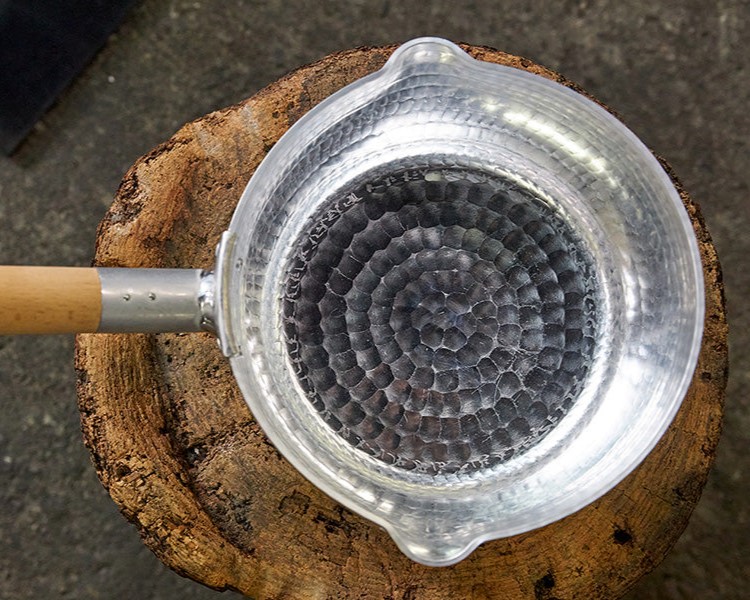A workshop in Yao City, Osaka Prefecture, established in 1924.
The company mainly manufactures kitchen utensils and cookware using copper and aluminum as raw materials,
The practical and beautiful utensils made with techniques passed down from generation to generation are loved by professional chefs,
The practical and beautiful utensils made with techniques passed down from generation to generation are loved by professional chefs.
The best pot-making workshop known to those in the know.
Good craftsmen make things that sound good. At the workshop of HIMENOSAKU Ltd. in Yao City, Osaka Prefecture, where few people know about it. in Yao City, Osaka Prefecture, the pleasant, musical sound of craftsman Toshikazu Himeno hitting the pots and pans echoes in your ears.
When I was a child, I really didn’t like the sound of banging pots and pans every day. After I actually took over the business, it was noisy and hard work, and on top of that, even if I made it, it would not sell well (laughs). I became determined to make pots and pans, wondering why I couldn’t make them well and why they didn’t sell. I have been thinking about how to hit the pots evenly and cleanly, the tools, how they sit, and how much force to put into them.

Handmade pots and pans loved by top chefs
At the age of 30, Mr. Himeno took over the pot-making factory established by his grandfather about 100 years ago in 1924. The Gyohira pots he makes are a favorite of professional chefs. They are characterized by their high thermal conductivity and even heat distribution. The heat is evenly transferred to the food, preventing it from getting burnt.
The high purity of aluminum is tightened by tapping and hammering, which makes the material stronger. In addition, the spreading of the pot’s skin increases heat conductivity, allowing the food to cook quickly and evenly. The heat of a typical kyohira pot is 2 mm, but ours is 3 mm, which is sturdier, retains heat better, and gives the pot a more stable feel.
Outstanding Skills and Experiences
The tsuchime, a characteristic of gyohei pots, is a pattern created by striking the material with a hammer to increase the strength of the metal. The shape is formed with each strike. In other words, it is a technique that relies on the craftsman’s sense, which cannot be re-hammered. The hammered patterns on the pots and pans created by Mr. Himeno’s rhythmic hammering are as beautiful as art.

A work that combines ease of use and functionality
The thermal conductivity of aluminum is said to be three times better than that of iron, and it is non-stick compared to iron or stainless steel. It also weighs only one-third as much as stainless steel, making it easy for women to handle. The oxide film that forms when exposed to air protects the inside from rust and corrosion, making it durable, and the smooth surface makes it easy to wash off and hygienic by preventing the growth of bacteria. It is truly a perfect product. In addition to gyohira pots, there are various other types of pots, such as oyako pots, tiered pots, and octagonal pots, and it is recommended to use different types depending on the purpose of cooking.
Currently, there are no more than 10 handmade nabe stores in Japan. Half of the orders are made to order. The pots are made to order according to the size, material, handle, etc., to suit the customer’s needs and preferences.
Once, I was asked to make a pot of gold, and when I got a quote, the price exceeded 10 million yen and it didn’t come to fruition (laughs). We have received many orders, but the most unusual was a large rugby ball displayed at the Kintetsu Higashi Hanazono Station building in front of the Hanazono Rugby Stadium. It was very big, so it was very difficult.

Creating products that will last a lifetime with their users
Toshikazu Himeno, the third generation of the company, has a desire that has not changed since he started producing HIMENOSAKU,
That is the idea of “products that can last a lifetime with their users. The life span of pots and pans sold on the market is two to three years. Even if they can be used for a long time, the maximum is 5 to 10 years. In this age of mass consumption and disposable products, this may be an old-fashioned idea, but I would like to continue to stamp “HIMENOSAKU” on my products every day without losing this idea. His pot-making skills, which are said to last for more than 50 years, are said to be the best in Japan. But the path of a craftsman has no end in sight.
I have never been satisfied with my work,” he says. I’ve never been satisfied, but maybe that’s why I never get tired of making pots and pans.

The idea of “products that can last a lifetime with the user” may be an antiquated concept in this age of mass consumption and disposable products, but we would like to continue to stamp “HIMENOSAKU. We will continue to stamp the “HIMENOSAKU” mark on our products every day.



